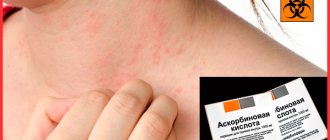Some people experience an excess of vitamin A in their body. This disease is accompanied by unpleasant symptoms and requires taking certain measures.
Not only a lack of vitamin A (hypovitaminosis), but also an excess (hypervitaminosis) has a negative impact on health.
Overdose occurs for certain reasons. If this happens, you need to take action and monitor your own well-being.
The benefits and harms of vitamin
Vitamin C is an essential element in the human body. Unfortunately, it is not produced independently, but comes only from the outside with food and drink. The element has many beneficial effects on organs and systems.
Actions:
- Takes part in collagen synthesis, carbon metabolism,
- Necessary for normal hematopoiesis,
- Promotes normal blood clotting,
- Reduces inflammation, promotes rapid recovery,
- Essential for gums, teeth, bones,
- Reduces the risk of developing allergic reactions,
- Helps relieve stress
- Has a beneficial effect on the immune system,
- Necessary for the absorption of other vitamins.
A lack of vitamin C leads to disruption of many body systems. If a person has bad habits, a minimum level of the element is diagnosed, so an increased dosage is allowed.
However, in some cases, vitamin C can cause harm and negative consequences. In what cases is an element dangerous?
Occasions:
- Presence of cataracts,
- High blood pressure,
- Diabetes,
- Tendency to form blood clots
- Kidney diseases,
- Salt diet.
In these situations, excess vitamin C can be harmful. Women during pregnancy are recommended to take the element after consultation with a specialist to avoid fetal rejection.
What to eat?
The highest levels of retinol are found in fish oil and beef liver. There is enough of it in dairy products - milk, cream, butter and cheeses, as well as chicken eggs.
Almost all bright yellow and red vegetables and fruits, as well as dark green leafy crops such as spinach, broccoli or green onions, are rich in carotenoids. There are carotenoids in legumes.
Together with fats, beta-carotene is absorbed 30 percent better. But only if it enters the body on an empty stomach, so this is not a reason to consume excess fat. For normal absorption of beta-carotene, the fats that a person receives during the day from food are sufficient.
Norm of vitamin "C" per day
What dosage of vitamin C is considered normal in adults and children? How much of an element is needed for the normal functioning of the body?
On average, adults are allowed to consume up to 80 mg of the substance per day and up to 40 mg for children. The maximum value should not exceed 90 mg per day. However, the amount of vitamin is allowed to be changed in some special cases.
During pregnancy, it is allowed to consume up to 100 mg of the substance per day, and during lactation - up to 120 mg. The dosage depends on many factors - ecology, bad habits, place of work, age, gender.
It is necessary to take preparations with vitamin C during meals. The dosage should be changed gradually; the therapeutic amount in some cases can reach 1500 mg. Maximum – intramuscular injection of 10 ml in the form of a solution.
Taking more than 30g of the substance at a time over a couple of days can lead to a serious overdose and death.
What if it's not enough?
Vitamin A deficiency disrupts the functioning of almost all body systems, and primarily affects appearance
. The skin becomes drier and begins to peel, wrinkles appear on the face and hands, and dandruff appears in the hair.
But the most well-known symptom of retinol deficiency is “ night blindness.”
» that is, decreased vision in twilight or low-light conditions. This condition is especially dangerous for those who have to spend a lot of time driving.
Retinol deficiency also causes other vision-related symptoms. Due to deterioration in the formation of tear fluid, a feeling of “sand” appears in the eyes, redness and itching of the eyelids. This is the so-called dry eye syndrome.
Men may notice a deficiency of this vitamin in the form of weakened erections.
and premature ejaculation.
Frequent respiratory diseases
and serious decrease in working capacity are also signs of vitamin A deficiency.
When is an overdose possible?
Why is it possible to develop an overdose? What can provoke intoxication and cause discomfort? In most cases, excess vitamin C does not cause any particular harm, but in the presence of certain factors, the appearance of an overdose and negative symptoms cannot be ruled out.
Factors:
- Lack of control when taking ascorbic acid, especially in children,
- Simultaneous consumption of foods with a high content of the element and vitamin complexes,
- Single dose of increased dosage.
When systematically taking more than one gram per day, the occurrence of hypervitaminosis and overdose cannot be ruled out.
Why is hypervitaminosis dangerous?
In general, the toxic effect of vitamins on the body depends on the effect a particular nutrient has on metabolism. The specific symptoms of poisoning will also depend on this. We will look at the main types of hypervitaminosis in more detail below.
You need to know that hypervitaminosis can be acute or chronic. Acute hypervitaminosis develops within a few days or even hours after ingestion of doses many times higher than daily requirements (tens or hundreds of times). In the acute course of hypervitaminosis, the development of the disease follows the pattern of acute toxicosis.
Hypervitaminosis is characterized by:
- rapid increase in the intensity of symptoms;
- weakness;
- nausea;
In some cases, dizziness, muscle tremors, and swelling occur. Due to persistent diarrhea, dehydration may occur.
Chronic hypervitaminosis develops slowly over several months. It occurs with the systematic use of excessive doses of vitamin preparations. Signs of hypervitaminosis are often blurred, making diagnosis difficult. To confirm the diagnosis, the doctor prescribes blood and urine tests.
Symptoms of excess vitamin c
What are the symptoms of excess vitamin C in the body?
How is an overdose of an element characterized? With prolonged use of an increased dosage in adults, various changes in the functioning of the body are diagnosed. Signs:
- Headaches
- High blood pressure,
- Unpleasant sensations in the kidneys,
- Irritation of the urinary tract mucosa, manifested by signs of cystitis,
- Allergic rashes on the skin,
- The presence of sugar in the urine, increased glucose levels,
- Gastritis of hyperacid form,
- Stomach upset,
- Severe vomiting
- Sleep disturbance,
- Heartburn,
- Visual impairment
- Nervousness, irritability,
- Increased fatigue, weakness, apathy.
In case of an overdose of such a substance in the body, the presence of various disturbances in the functioning of organs and systems is noted. Stones may form in the kidneys and gall bladder, and disruptions in the functioning of the cardiac system may occur.
With long-term use of an increased dosage, the development of irreversible changes in the functioning of the kidneys, adrenal glands, and pancreas cannot be ruled out. If signs of an overdose of vitamin C appear, you should contact a medical facility.
Hypervitaminosis B
Hypervitaminosis B develops much less frequently than an overdose of fat-soluble vitamins. However, this is possible when using synthetic drugs in the form of injections.
Here are some characteristic symptoms of an overabundance of various B vitamins.
- B2 - dysfunction of the liver, heart muscle, photophobia, dermatitis in the corners of the mouth.
- B6 - when the daily requirement is exceeded by 1 thousand times (2–5 g), a disturbance in the activity of the peripheral nervous system develops (loss of sensitivity in the arms and legs, aching pain along the nerves).
- B9 - tonic cramps in the calf muscles, occurring at any time of the day without any apparent reason.
- B12 - prescribed 0.1 mg daily for the treatment of anemia. With long-term treatment, allergic reactions, blood stagnation in the lungs and heart vessels, and thrombosis of peripheral vessels are possible.
- An overdose of folate (vitamin B9) occurs when consuming more than 20 mg per day. They can cause kidney dysfunction, pernicious anemia, and in severe cases, myelosis (damage to the spinal cord).
Hypervitaminosis PP (vitamin B3) is caused by exceeding the daily requirement (15–20 mg) by 100 times or more. It is characterized by an acute course, nausea, diarrhea, and extensive redness of the skin quickly develop.
Methods and methods of treating overdose
How is ascorbic acid overdose treated?
The victim needs to be given more water to drink. Vitamin C is highly soluble, so when you consume liquid, its concentration will decrease and the excess will be excreted by the kidneys. When taking a large amount of a substance at a time and diagnosing an overdose, it is necessary to provide first aid to the victim.
- Gastric lavage is performed with a large volume of water,
- A victim of an overdose is given activated charcoal, it will help quickly remove toxic substances.
- It is recommended that in case of an overdose, the patient should be given more water to drink; this action will speed up the process of removing excess elements.
The method of further treatment of an overdose after first aid is chosen by a medical professional. For mild poisoning, therapy at home is allowed; severe poisoning requires careful treatment in a medical facility. Actions carried out in the hospital are aimed at reducing the level of vitamin in the body and improving the functioning of internal organs.
First aid
Ascorbic acid is highly soluble in aqueous media and is therefore quickly excreted by the renal system.
- At the first suspicion of an overdose, you should ensure that you drink plenty of fluids and stop taking further vitamins.
- When using excessively high doses of the drug one-time, it is necessary to quickly remove it from the body, for which you need to induce vomiting and rinse the stomach.
- Then you need to take an adsorbent drug like activated carbon or Smecta.
- If you drink plenty of water, water-soluble ascorbic acid will be absorbed by the body in the quantities it needs, and the rest will be excreted by the kidneys in urine. But you need to drink a lot of water.
- And the adsorbent taken in time will absorb excess vitamins from the gastrointestinal system, neutralize them and quickly remove them from the body.
Further tactics for treating overdose are chosen by a specialist. If the overdose is minor, then the patient is allowed to stay at home for treatment, but in case of serious intoxication, hospitalization may be required.
How to remove excess vitamin C
Vitamin C is highly soluble in water, so the easiest way to reduce the level of the element in the body is to drink plenty of liquid. Excess is removed through the kidneys.
It is recommended to monitor your diet, not abuse foods with high content of substances, and take synthetic drugs correctly.
A mild overdose of vitamin C does not cause any particular harm to the human body, but in some cases it can lead to unpleasant symptoms. If suspicious signs occur, it is recommended to contact a medical facility.
Hypervitaminosis E
Vitamin E, or tocopherol, accumulates in the body quite quickly, and its breakdown occurs slowly. In this regard, there are cases of hypervitaminosis due to excessive intake of synthetic tocopherol preparations. Compared to vitamins A and D, tocopherols are not as toxic: exceeding the daily requirement by 10–20 times will not have any health consequences. Excess tocopherol is excreted in bile.
Symptoms of hypervitaminosis E are nonspecific, so to make a diagnosis it is very important to have information about the patient’s intake of vitamin preparations.
With an excess of tocopherols, the following symptoms may occur:
- weakness;
- double vision;
- diarrhea.
An excess of vitamin E in the body impairs the absorption of other fat-soluble vitamins, which leads to hypovitaminosis A and D. Regular intake of more than 1 g of tocopherol per day causes an increase in blood pressure, an increase in the liver in size, disturbances in the composition of the blood and hemorrhages in the brain.
Treatment of hypervitaminosis E is symptomatic.
How to take vitamin C correctly - video
Read more:
Signs of kidney cancer
Gastritis is a disease of modern man
How to remove uric acid from the body: traditional methods
First aid for carbon monoxide poisoning for children and adults
Dentistry. Prevention of gum disease
Article rating:
Share with friends:
You may also be interested in:
Eutirox overdose - symptoms and consequences, what to do for pregnant women.
Is it possible to be poisoned by the drug Revit?
What to do in case of overdose of Polydexa in children and adults - symptoms and treatment
Overdose of duphaston during pregnancy - consequences for the child
Hypervitaminosis A
Excess vitamin A is a classic example of hypervitaminosis. The first cases of poisoning were described by the Dutch traveler de Veer in 1597, when he and his people fell ill after eating the liver of a polar bear.
You can also get poisoned by eating the liver of a shark, sea animals, or northern huskies; in case of overdose of medications or uncontrolled use of vitamins and fish oil for a long time.
Retinol preparations are prescribed for infectious diseases, rickets, skin diseases, and night blindness. It is taken orally; if this is not possible (for nausea, vomiting, postoperative conditions), intramuscular injections are given.
The daily requirement of retinol for adults is 700–900 mcg, for children 300–400 mcg. The permissible intake level for adults is 3 thousand mcg per day, for children - 600 mcg (1 IU is equal to 0.3 mcg of retinol).
Acute hypervitaminosis occurs when more than 25 thousand IU per kg of a person’s weight is ingested, chronic - 4 thousand IU per kg of weight for six months or more. Simply put, a toxic dose for an adult would be taking from 100 thousand to 500 thousand IU, and for a child from 50 thousand to 100 thousand IU of vitamin A.
Up to 90% of incoming vitamin A accumulates in the liver. Neutralization occurs very slowly: in three weeks, only 34% of the administered dose is eliminated from the body.
By the way, the plant form of vitamin A - carotenes - is non-toxic even in high doses, but they cannot completely replace vitamin A of animal origin. With excessive consumption of carotenoids, yellowing of the mucous membranes, skin of the palms and soles is observed.
Symptoms of hypervitaminosis A in adults are as follows:
The acute form of hypervitaminosis is accompanied by convulsions and paralysis, uncontrollable vomiting, and short-term loss of consciousness.
hair loss
Symptoms of hypervitaminosis A in chronic course:
- increased intracranial pressure;
- visual impairment;
- bleeding gums, tendency to nosebleeds;
- increased blood cholesterol;
- dryness and flaking of the skin;
- hair loss;
- brittle nails.
Signs of liver and kidney damage develop. With chronic excess of vitamin A, spontaneous bone fractures can occur.
With increased intake by pregnant women, it can cause congenital deformities in the fetus. Therefore, large doses of retinol should not be prescribed to pregnant women (especially at an early stage) and six months before pregnancy.
For the treatment of hypervitaminosis A, Mannitol is prescribed to reduce intracranial pressure, glucocorticoids to accelerate metabolism in the liver; vitamin E to stabilize cellular metabolism.
Precautionary measures
People taking certain medications or who have certain medical conditions should not take vitamin C (especially in high doses) because vitamin C can interact with a number of medications.
Vitamin C may affect the following medications:
- certain cancer treatments (possibly chemotherapy).
- birth control pills.
- Aspirin.
- medications used to control cholesterol levels.
- blood thinners such as warfarin (Coumadin).
- antipsychotic drugs (such as lupenazine or prolixin).
- antiretroviral drug Crixivan.
Anyone taking these medications should avoid taking high doses of a vitamin C supplement without a doctor's supervision.











